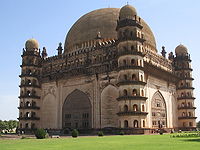- Mohammed Adil Shah
-
amaresh ADIL SHAHI EMPEROR Reign 1626–1655 Full name Sultan Muhammad Adil Shah Gazi Birthplace Bijapur Died 1655 Place of death Bijapur Predecessor Ibrahim Adil Shah II Successor Ali Adil Shah II Consort to 1) Taj Jahan Begum D/o Hazrat Abdur Rahman Quadri 2) Khudeeja Sultana of Golkonda
3) Uroos BegumOffspring Ali Adil Shah II Royal House House of Osman Dynasty Adil Shahi Empire Father Ibrahim Adil Shah II Mother Taaj Sultana or Badi Sahiba Religious beliefs Sunni Muslim Muhammad Adil Shah was the ruler of Bijapur, ascending the throne in 1627 at the comparatively young age of sixteen years. This was accomplished with the help of two Bijapuri nobles – Daulat Khan (later entitled as Khawas Khan) and Mirza Muhammad Amin Lari (later entitled as Mustafa Khan).
Muhammad’s glorious reign of thirty years witnessed some momentous historical events.
Bijapur became partner with the Mughals in the extinction of Ahmednagar. Muhammad maintained friendly relations with Shah Jahan and made the peace treaty of 1636, after the extinction of Ahmednagar. And by a farman of Shah Jahan he got assurances for the security of the independence of Bijapur from the Mughal aggression. Due to his good relations, Shah Jahan formally recognized Muhammad’s sovereignty and bestowed on him the title of SHAH in 1648, the only ruler of Bijapur to receive such recognition from the Mughals.
The Treaty of 1636, with the Mughals sealed the expansion of Bijapur in the north. So Muhammad Adil Shah extended his dominations westwards into Konkan, Pune, Dhabul (present Mumbai), southwards into Mysore, and eastwards into Karnataka, present south Andhra Pradesh and Tamil Nadu. During his reign, the kingdom attained its greatest extent, power and magnificence, and his dominious stretched from the Arabian Sea to the Bay of Bengal.
Besides territorial expansions, Bijapur also attained peace and prosperity during Muhammad’s reign. His kingdom yielded an annual revenue of seven crore eighty four lakh rupees, besides five and half crores of tributes were vassal rulers and zamindars. Cultural activities like poetry, painting and architecture also received a great impetus. Muhammad Adil Shah did his best to emulate the glorious traditions left to him by his versatile father. Diffusion of general education and religious teachings were one of his chief concerns, and he did his utmost to improve the socio-economic and educational standards of the people.
The colossal mausoleum of Muhammad Adil Shah, now named Gol Gumbaz depicts even to this day, after a lapse of four centuries, the glory that Muhammad’s reign had attained. It is the greatest structural triumphs of Indo-Perso-Ottoman architecture of Adil Shahi period.
Muhammad was the first ruler of Adil Shahi dynasty to make a departure from the injunctions against figure and portraint painting that was scrupulously adhered to till his father’s reign. He introduced fresco paintings and portraits, the examples of which are the walls of Asar Mahal, pavilion at Kumatgi and Sat Manzil.
Muhammad’s reign witnessed revolt of Shahaji and then, the rise of Shivaji to eminence and his founding of an independent Maratha State, which was initially carved out from the Bijapur Kingdom. In spite of the glory and power that Muhammad achieved he failed to check the rise of Marathas to independence.
His Tomb
He was buried in the Gol Gumbaz, near the tomb of his spiritual teacher Hazrat Hashimpeer Dastageer. Hazrath Hashimpeer arrived in Bijapur at the rule of Ibrahim Adil Shah II. Hazrath Hashimpeer influenced the rulers of Bijapur to give up their un-Islamic and heretic practices. Gol Gumbaz, located near the shrine the of Hazrath Hashimpeer, owes its completion to the 10 years of life that Hazrath Hashimpeer granted to his disciple Sultan Mohammed Adil Shah.
The Gol Gumbaz dome is the second largest in the world, 124 feet in diameter 44 m in diameter. The Gol Gumbaz complex includes a mosque, a Naqqar Khana (a hall for the trumpeters) (Now it is used as museum) and the ruins of guest houses.
References
- Wakiyate Mamlakate Bijapur by Basheeruddin Dehelvi[Full citation needed]
- Tareekhe Farishta by Kasim Farishta[Full citation needed]
- External Relation of Bijapur Adil Shahis[Full citation needed]
Preceded by
Ibrahim Adil Shah IIAdil Shahi Rulers of Bijapur
1627–1657Succeeded by
Ali Adil Shah IICategories:- 1601 births
- 1657 deaths
- Sultans of Bijapur
- Adilshahi
- 17th-century Indian people
Wikimedia Foundation. 2010.

